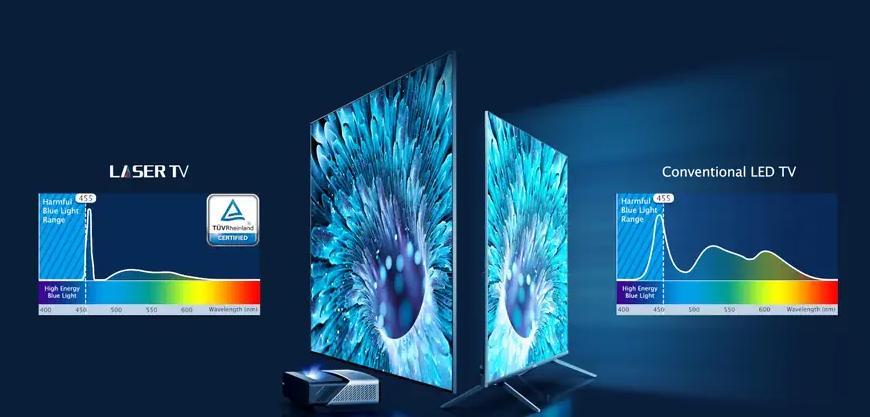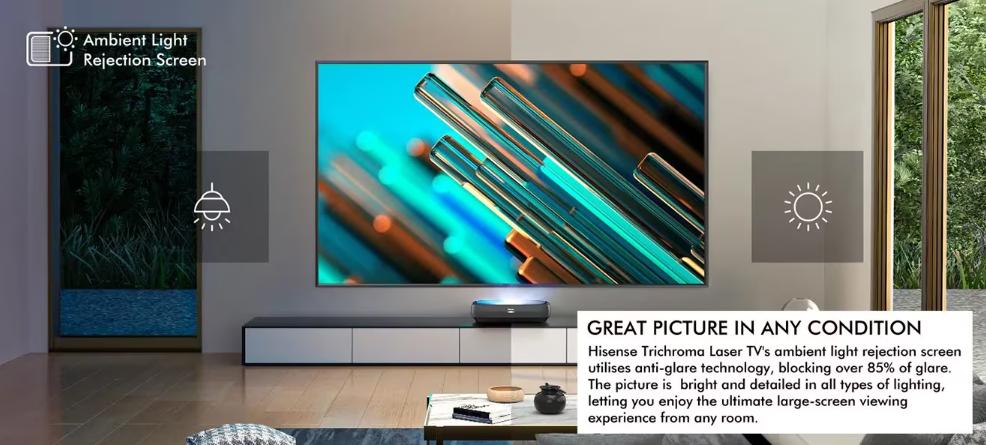




Table of Contents
- Introduction
- Laser TV vs LED TVs: A Detailed Comparison
- Conclusion
- Faq's
Introduction
When shopping for a new television, two terms that often come up are Laser TVs and LED TVs. With rapidly advancing technology, the options available can make the decision-making process a bit overwhelming. But what exactly differentiates a Laser TV from an LED TV? In this article, we'll dive into the unique features, advantages, and drawbacks of each, helping you make an informed choice for your home entertainment needs.

Laser TV vs LED TVs: A Detailed Comparison
When choosing the right TV for your home, it's important to understand the unique advantages and limitations of Laser TVs and LED TVs. Both types of televisions have distinct characteristics, and depending on your needs, one might be a better fit than the other. In this comparison, we'll delve into the specifics with numbers and figures to give you a clearer picture.
1. Technology
-
Laser TV: Laser TVs utilize laser light sources for projection. They offer higher brightness levels, often ranging from 3000 to 6000 lumens, depending on the model. This allows them to project images onto large screens, even in rooms with ambient light.
-
Projection Size: Laser TVs can project images up to 120-150 inches. Some advanced models can even project up to 200 inches without losing picture quality.
-
-
LED TV: LED TVs are essentially an LCD TV with LED backlighting, providing great image clarity but with a limited range of brightness. Most mid to high-end LED TVs offer a brightness level of about 400-1000 nits, suitable for regular living rooms or dark rooms.
-
Screen Size: LED TVs typically range from 32 inches to 85 inches. They are widely available in a variety of sizes, but screens larger than 85 inches are less common.
|
-
2. Picture Quality
-
Laser TV: Laser TVs stand out in terms of color accuracy and brightness. They can cover a wider color gamut, often exceeding 90-100% of DCI-P3, the color standard used in the film industry. This allows for more vivid and lifelike colors. Their contrast ratios are significantly higher, making dark scenes look much deeper and more detailed.
-
Resolution: Many Laser TVs come in 4K resolution, with some premium models offering 8K support.

-
-
LED TV: While LED TVs also offer impressive picture quality, especially with newer Quantum Dot or Mini-LED technology, they still can't match the contrast levels of Laser TVs. The color gamut on high-end LED TVs can reach 70-90% of DCI-P3, depending on the model, which is lower than Laser TVs.
-
Resolution: LED TVs typically offer Full HD (1080p), 4K, and 8K resolutions, with 4K becoming the standard in most models.
-
3. Size and Space Considerations
-
Laser TV: Laser TVs are designed for large spaces, making them ideal for home theaters or big living rooms. As previously mentioned, these TVs can project onto screens as large as 150 inches or even up to 200 inches. To achieve this, you'll need a special screen to display the projected image, which adds to the setup complexity. The larger size also means Laser TVs are best suited for rooms with dedicated space.
-
LED TV: LED TVs come in a wider range of sizes, from small 32-inch models to large 85-inch models. They are better suited for rooms where wall space is more limited. These TVs are easier to install compared to Laser TVs, as they do not require a projection screen or special installation.
4. Price
-
Laser TV: Laser TVs are a premium option. Entry-level Laser TVs start at around ₹1,00,000 and can go up to ₹8,00,000 or more for high-end models with advanced features like 8K resolution and exceptional brightness levels.
-
LED TV: LED TVs are much more affordable. Budget-friendly models start at around ₹20,000, while mid-range LED TVs with 4K resolution range from ₹40,000 to ₹1,50,000. Premium 8K LED TVs can go up to ₹3,00,000.
5. Energy Efficiency
-
Laser TV: While Laser TVs are more energy-efficient than traditional bulb-based projectors, they still consume more power than LED TVs due to their high brightness output. A Laser TV might consume around 200-400 watts depending on the model and size.
-
LED TV: LED TVs are highly energy-efficient. For example, a typical 55-inch LED TV consumes around 60-100 watts of power, which is significantly lower than a Laser TV.
6. Viewing Angle
-
Laser TV: One of the key advantages of Laser TVs is their wide viewing angles. With laser projection, the image remains consistent and bright even when viewed from the side. Laser TVs typically offer better performance in large rooms with multiple seating positions.
-
LED TV: LED TVs are more sensitive to viewing angles. When viewed from an angle beyond 30-40 degrees, the picture can appear dimmer, with colors becoming washed out. However, IPS panels found in certain LED TVs help improve the viewing angles.
Conclusion
If you are looking for an immersive, cinematic experience, particularly in a large room or home theater setup, a Laser TV is the better choice. With its exceptional picture quality, superior brightness, and the ability to project massive screen sizes, it is the ideal solution for movie lovers and those who enjoy a theater-like experience at home.
However, if you're working with a smaller budget, have limited space, or need something that is energy-efficient and easy to set up, an LED TV will offer excellent performance at a fraction of the cost. With a wide range of sizes, affordable pricing, and solid picture quality, LED TVs are perfect for everyday viewing in more compact spaces.
explore further
Latest from Home Buying Tips
More from Recommendations
Resources
Dwello, for every home buyer, is a way to go from 'I feel' to 'I know', at no extra cost.




